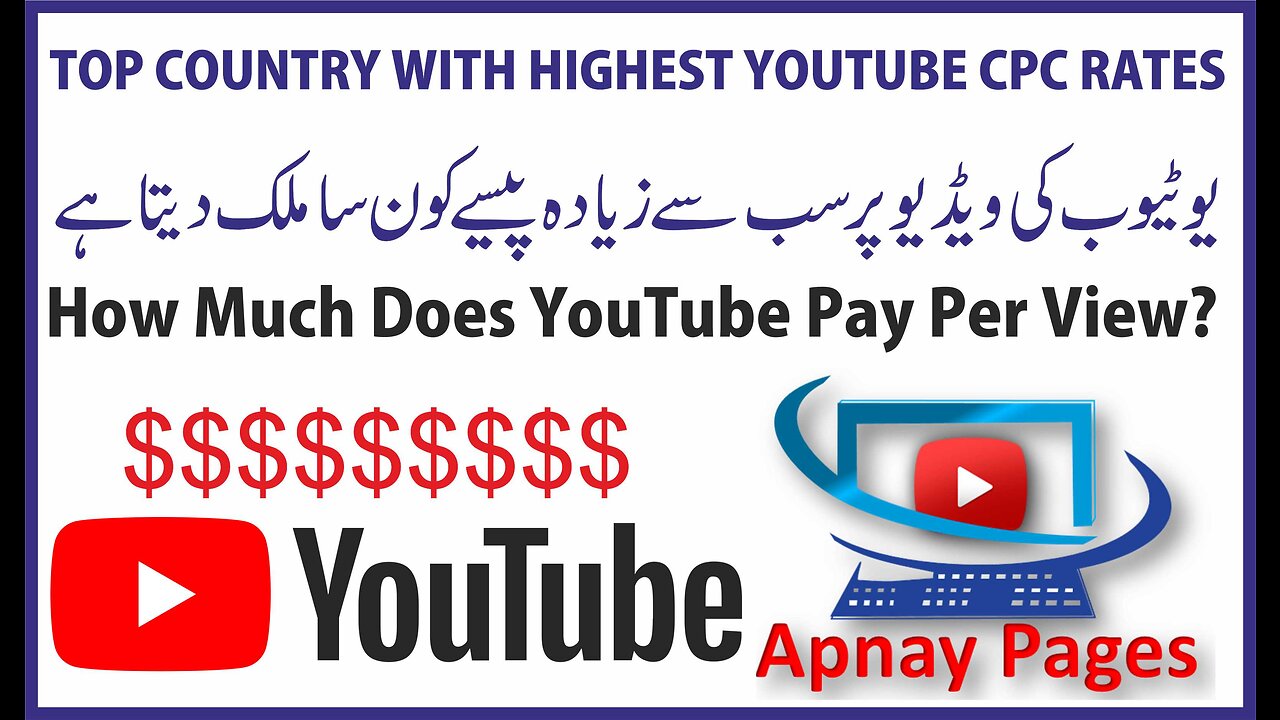Premium Only Content

Top Country with highest YouTube CPC Rates
Top Country with highest YouTube CPC Rates
https://youtu.be/LDKDKf19FJ8
How Much YouTube Pays Per View: The Simplified Math
Are you a YouTube content creator wondering how much you can earn per view? While the exact amount can vary depending on a variety of factors, including the type of content, audience engagement, and location, we can simplify the math to give you a general idea.
On average, YouTube pays content creators around $0.01 to $0.03 per view, which equates to $1 to $3-$5 per 1,000 views. This is based on the CPM (cost per mile) rates that advertisers pay to have their ads shown on YouTube videos. For example, if a video receives 1 million views with an average CPM of $2, the creator can earn around $2,000.
It’s important to note that YouTube takes a percentage of the revenue generated by ads, so the exact amount paid to creators may be lower than the estimated range. Additionally, the amount can vary depending on the content and audience demographics, as advertisers may be willing to pay more for certain types of content and demographics.
Overall, while the amount YouTube pays per view may seem small, it can add up quickly with a large and engaged audience. By consistently creating high-quality content and building a loyal following, content creators can maximize their earnings on the platform.
What is CPM?
CPM stands for “Cost Per Mille”, which is a marketing term used to describe the price advertisers pay for every thousand impressions (or views) of an advertisement.
On YouTube, CPM is an important factor in determining how much a content creator can earn from their videos. Advertisers bid to have their ads shown on YouTube videos, and the CPM rate they pay can vary depending on factors such as the type of ad, the targeted audience, and the content creator’s location.
For example, if an advertiser pays a $2 CPM rate for their ad, it means they will pay $2 for every thousand times their ad is displayed on YouTube videos. The amount that YouTube pays to the content creator for displaying the ad on their video can also vary based on factors such as the location of the viewer and the type of ad.
CPM rates can fluctuate over time and can also vary depending on the specific niche or industry being targeted. Content creators can optimize their earnings on YouTube by producing high-quality videos that attract a larger and more engaged audience, which can increase the CPM rates offered by advertisers.
What is RPM?
RPM stands for “Revenue Per Mille” and is a metric used by YouTube to calculate the estimated revenue earned by a content creator for every thousand views on their videos.
Unlike CPM, which is the cost that advertisers pay per thousand views of an ad, RPM is the revenue that the content creator earns per thousand views of their video. The RPM includes not just the ad revenue, but also other sources of revenue such as YouTube Red subscription fees, channel memberships, and Super Chat donations.
The formula to calculate RPM is as follows:
RPM = (Estimated Earnings / Total Views) x 1000
For example, if a content creator earns an estimated $100 from their YouTube videos and gets 10,000 total views, their RPM would be calculated as:
RPM = ($100 / 10,000) x 1000 = $10
The RPM metric is a useful tool for content creators to track their earnings and optimize their revenue strategies. By monitoring their RPM and experimenting with different types of content, ad placements, and audience engagement strategies, creators can maximize their earnings on the platform.
What is CPC?
CPC stands for “Cost Per Click”, which is a pricing model used in online advertising. CPC is the amount that advertisers pay each time a user clicks on their ad, regardless of whether or not the user converts into a customer.
On YouTube, CPC can impact the amount that content creators earn from displaying ads on their videos. This is because advertisers bid for ad placements on YouTube videos based on the CPC they are willing to pay. The higher the CPC, the more the advertiser is willing to pay for each click, and the more likely their ad is to be displayed on the video.
The amount of CPC that advertisers are willing to pay can vary depending on factors such as the industry, the targeted audience, and the competition for ad placements. Content creators can optimize their earnings by producing high-quality content that attracts a larger and more engaged audience, which can lead to higher CPC rates from advertisers.
It’s worth noting that while CPC can impact the amount earned by content creators, it is not the only factor that determines earnings. Other metrics, such as CPM and RPM, also play a role in determining how much content creators can earn from displaying ads on their videos.
YouTube Revenue Sharing Model
The YouTube revenue-sharing model allows content creators to earn money by displaying ads on their videos. YouTube shares a portion of the revenue generated from ads with content creators, with the exact percentage varying depending on several factors.
In general, the revenue-sharing model on YouTube works as follows:
Advertisers bid to have their ads displayed on YouTube videos.
YouTube displays ads on eligible videos and shares a portion of the ad revenue with the content creator.
The revenue shared with the content creator is based on factors such as the type of ad, the location of the viewer, and the percentage of the ad viewed by the viewer.
YouTube takes a percentage of the revenue generated from ads as their fee for providing the platform and managing the ad network.
The exact percentage of revenue that content creators earn from ads can vary depending on several factors, including their location, the type of ad, and their agreement with YouTube. In general, content creators can expect to earn between 45% and 55% of the ad revenue generated from their videos.
highest youtube cpm countries 2023,
norway cpm youtube,
youtube cpm in usa,
youtube rpm rates,
youtube cpm rates by category,
what is youtube cpm,
high cpm countries for facebook,
highest cpm youtube,
-
 8:19
8:19
Mr Amazing
8 days agoAny thoughts
28 -
 2:37:43
2:37:43
Flyover Conservatives
23 hours agoDR. KIRK ELLIOTT | Deep Dive: Tariffs, Tech, and Total Economic Warfare – Who Wins and Who Loses? | In Studio - FOC Show
42.4K2 -

Danny Polishchuk
8 hours agoTariffs and Trade Wars + Nick Rochefort | Low Value Mail #136
30.3K1 -
 2:04:40
2:04:40
I_Came_With_Fire_Podcast
10 hours agoCartels vs The United States, Fentanyls 2 Front WAR, and FTOs
14.1K -
 4:54
4:54
CryptoWrld
11 hours ago $1.07 earnedCrypto Startup Launches Tokenized US Treasury Bonds
20K2 -
 2:29:15
2:29:15
We Like Shooting
17 hours ago $0.43 earnedWe Like Shooting 596 (Gun Podcast)
14K -
 54:43
54:43
Kimberly Guilfoyle
10 hours agoThe Trump Effect: Mexico Folds, Live with Dinesh D’Souza & Chuck DeVore | Ep.193
98.1K32 -
 1:20:47
1:20:47
Redacted News
9 hours agoMexico CAVES to Trump over tariffs, USAID Shutdown, & Zelensky loses $200 billion | Redacted Live
177K422 -
 1:02:29
1:02:29
The StoneZONE with Roger Stone
5 hours agoIs GOP Sen. Bill Cassidy Playing Politics with RFK Jr. Vote as U.S. Faces Public Health Crisis?
30.7K5 -
 1:10:30
1:10:30
BIG NEM
8 hours ago📢 THE JOLLOF-OFF: The Battle for West African Cuisine! 🇳🇬🔥🇬🇭
28.5K4